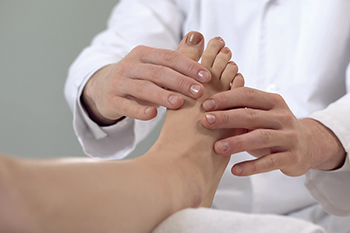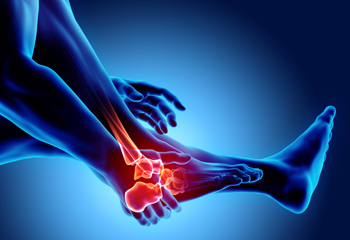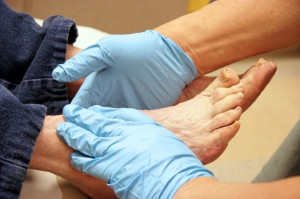September 2022
How Do Blisters Develop?

Blisters are generally caused by excess friction that can come from wearing socks and shoes that do not fit correctly. The tissues and blood vessels can become damaged, and may result in a blister. It is defined as a small area that is filled with protective liquid, and forms over the damaged skin. It is the body’s natural healing process that allows new skin to form underneath the blister. It is a common ailment among runners, and a protective covering may have to be worn over it while running. When the skin has formed, the blister will gradually drain, as it is not needed any longer. A red spot where the blister forms often appears first, and this can be a warning sign to take proper precautions to protect the feet. Blisters may develop for other reasons, including having an allergic reaction, or possibly from a skin condition such as eczema or psoriasis. If you frequently get blisters on your feet, it is suggested that you consult with a podiatrist who can offer you correct treatment options, and discuss preventive methods with you.
Blisters may appear as a single bubble or in a cluster. They can cause a lot of pain and may be filled with pus, blood, or watery serum. If your feet are hurting, contact Dr. Mark Spier of Maryland. Our doctor can provide the care you need to keep you pain-free and on your feet.
Foot Blisters
Foot blisters are often the result of friction. This happens due to the constant rubbing from shoes, which can lead to pain.
What Are Foot Blisters?
A foot blister is a small fluid-filled pocket that forms on the upper-most layer of the skin. Blisters are filled with clear fluid and can lead to blood drainage or pus if the area becomes infected.
Symptoms
(Blister symptoms may vary depending on what is causing them)
- Bubble of skin filled with fluid
- Redness
- Moderate to severe pain
- Itching
Prevention & Treatment
In order to prevent blisters, you should be sure to wear comfortable shoes with socks that cushion your feet and absorb sweat. Breaking a blister open may increase your chances of developing an infection. However, if your blister breaks, you should wash the area with soap and water immediately and then apply a bandage to the affected area. If your blisters cause severe pain it is important that you call your podiatrist right away.
If you have any questions, please feel free to contact one of our offices located in Columbia and Reisterstown, MD . We offer the newest diagnostic and treatment technologies for all your foot care needs.
The Feet Can Develop Forms of Arthritis

Arthritis is a painful condition that can affect the feet. There are several forms of arthritis and each one can develop in different parts of the foot. Osteoarthritis can cause bony spurs on the bottom of the big toe as a result of damaged cartilage. This can often lead to bunions developing and many patients have to purchase wider shoes. Inflammation of the joints in the ball of the foot may be indicative of rheumatoid arthritis. This may result in ligaments that become loose which may help the bone to push against the skin of the sole. Mild relief may be felt when a portion of leather is placed in the shoe as this may be helpful in moving the pressure to the center of the foot. An extremely painful form of arthritis is known as gout, which can develop from genetic reasons or from eating foods that have high levels of purines. These types of foods may cause excess uric acid and can lodge in the joints of the big toe. If you have foot pain, it is strongly advised that you consult with a podiatrist who can properly diagnose arthritis in the feet as well as offer treatment methods.
Arthritis can be a difficult condition to live with. If you are seeking treatment, contact Dr. Mark Spier from Maryland. Our doctor can provide the care you need to keep you pain-free and on your feet.
Arthritic Foot Care
Arthritis is a joint disorder that involves the inflammation of different joints in your body, such as those in your feet. Arthritis is often caused by a degenerative joint disease and causes mild to severe pain in all affected areas. In addition to this, swelling and stiffness in the affected joints can also be a common symptom of arthritis.
In many cases, wearing ill-fitting shoes can worsen the effects and pain of arthritis. Wearing shoes that have a lower heel and extra room can help your feet feel more comfortable. In cases of rheumatoid arthritis, the arch in your foot may become problematic. Buying shoes with proper arch support that contour to your feet can help immensely.
Alleviating Arthritic Pain
- Exercises that stretch the foot can prevent further pain and injury and increase mobility
- Most of the pain can be alleviated with anti-inflammatory drugs, heat, and topical medications
- Massages can help temporarily alleviate pain.
It is best to see your doctor for the treatment that is right for your needs and symptoms. Conditions vary, and a podiatrist can help you determine the right method of care for your feet.
If you have any questions, please feel free to contact one of our offices located in Columbia and Reisterstown, MD . We offer the newest diagnostic tools and technology to treat your foot and ankle needs.
Different Types of Foot and Ankle Surgeries

Foot or ankle surgery can be recommended by a podiatrist to relieve pain, correct a foot deformity, or restore function to a foot or ankle. It is often a last resort, after more conservative treatments are prescribed. Such surgery is usually elective and takes place in a podiatrist’s office, in a hospital, or a surgery center. Whether or not surgery is suggested depends on one’s age, medical history, and insurance coverage. Once surgery is done, the patient must follow instructions for the foot or ankle to heal properly and without complications. Foot surgeries can include toenail removal, and arthroscopic foot or ankle surgery. This is a type of endoscopy that allows a doctor to investigate an area of the body without cutting it open. Additional types of surgeries can consist of plantar fascia release, and ankle fusion or replacement. If you have foot or ankle problems and pain interferes with your daily life, see a podiatrist for proper diagnosis and treatment. Surgery may be appropriate if other treatments are ineffective.
Foot surgery is sometimes necessary to treat a foot ailment. To learn more, contact Dr. Mark Spier of Maryland. Our doctor will assist you with all of your foot and ankle needs.
When Is Surgery Necessary?
Foot and ankle surgery is generally reserved for cases in which less invasive, conservative procedures have failed to alleviate the problem. Some of the cases in which surgery may be necessary include:
- Removing foot deformities like bunions and bone spurs
- Severe arthritis that has caused bone issues
- Cosmetic reconstruction
What Types of Surgery Are There?
The type of surgery you receive will depend on the nature of the problem you have. Some of the possible surgeries include:
- Bunionectomy for painful bunions
- Surgical fusion for realignment of bones
- Neuropathy decompression surgery to treat nerve damage
Benefits of Surgery
Although surgery is usually a last resort, it can provide more complete pain relief compared to non-surgical methods and may allow you to finally resume full activity.
Surgical techniques have also become increasingly sophisticated. Techniques like endoscopic surgery allow for smaller incisions and faster recovery times.
If you have any questions please feel free to contact one of our offices located in Columbia and Reisterstown, MD . We offer the newest diagnostic and treatment technologies for all your foot and ankle needs.
Shared Symptoms of Diabetes Type 1 and Diabetes Type 2

Both Type 1 Diabetes and Type 2 Diabetes can produce long-term complications due to increased levels of glucose (sugar) in the blood. They also share several similar symptoms. For instance, when your body struggles to expel excess amounts of sugar from your blood, you may urinate frequently or get excessively thirsty. Diabetes can also make it difficult for cells to absorb glucose in the blood and convert it into energy, causing you to feel fatigued and weak. A decrease in fluids may cause dry mouth and itchy skin, and disruptions in insulin production or use can affect your ability to get energy from food—making you lose weight unexpectedly or be hungrier than usual. Your feet are often the first area to exhibit signs of diabetes. High glucose levels in the blood can cause nerve damage in the feet, which can result in numbness, burning, tingling, or swelling. This can make it difficult for you to feel when you have a cut or bruise on your feet. Poor circulation associated with diabetes can exacerbate this problem by decreasing the body’s ability to heal any such injury, and wounds may develop. This can be problematic in people with diabetes and may lead to far more serious complications if it is not managed and treated properly. That is why a podiatrist is a critical part of your health team should you be diagnosed with diabetes.
Diabetic foot care is important in preventing foot ailments such as ulcers. If you are suffering from diabetes or have any other concerns about your feet, contact Dr. Mark Spier from Maryland. Our doctor can provide the care you need to keep you pain-free and on your feet.
Diabetic Foot Care
Diabetes affects millions of people every year. The condition can damage blood vessels in many parts of the body, especially the feet. Because of this, taking care of your feet is essential if you have diabetes, and having a podiatrist help monitor your foot health is highly recommended.
The Importance of Caring for Your Feet
- Routinely inspect your feet for bruises or sores.
- Wear socks that fit your feet comfortably.
- Wear comfortable shoes that provide adequate support.
Patients with diabetes should have their doctor monitor their blood levels, as blood sugar levels play such a huge role in diabetic care. Monitoring these levels on a regular basis is highly advised.
It is always best to inform your healthcare professional of any concerns you may have regarding your feet, especially for diabetic patients. Early treatment and routine foot examinations are keys to maintaining proper health, especially because severe complications can arise if proper treatment is not applied.
If you have any questions please feel free to contact one of our offices located in Columbia and Reisterstown, MD . We offer the newest diagnostic and treatment technologies for all your foot and ankle needs.










